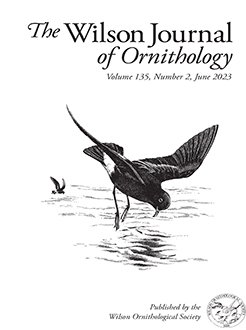Annual migrations are energetically challenging for migratory passerines and represent a potentially stressful period of the annual cycle, particularly during brief refueling periods at stopover sites. Shoreline habitats near the Great Lakes in eastern North America support many landbird migrants; however, environmental factors—including food availability and unpredictable weather—may impact the health and physiological condition of these birds during refueling periods. The aim of this study at the Braddock Bay Bird Observatory was to use key blood metrics (plasma metabolite profiling and leukocyte counts) to assess annual and within-season variation in nutrient utilization and physiological condition of 3 species of Catharus thrushes with known variation in migration strategy and passage timing. We observed similar plasma triglyceride concentrations across species; however, glucose and uric acid were elevated in a short-distance migrant, the Hermit Thrush (Catharus guttatus). Furthermore, Hermit Thrush showed higher heterophil/lymphocyte ratios than Gray-cheeked Thrush (C. minimus) or Swainson's Thrush (C. ustulatus). Year was an important factor in all analyses exploring variables that may influence nutrient utilization or chronic stress. Our results suggest that thrushes with diverse migration strategies do not significantly differ in fat deposition patterns at the site, but end-of-season migrants may consume different resources and display increased chronic stress levels as they experience reduced food availability with the progression of autumn migration. We additionally propose that annual variation detected in this multi-year study underscores the importance of physiological condition metrics as tools for assessing yearly patterns in refueling performance at stopover sites, which is especially relevant in light of the continuing pressures of invasive species and environmental change.
Las migraciones anuales son energéticamente demandantes para aves paserinas migratorias y representan un periodo potencialmente estresante en su ciclo anual, particularmente en los periodos breves de reabastecimiento en sus sitios de parada migratoria. Habitats ribereños cerca de los Grandes Lagos del este de Norteamérica mantienen a muchas aves terrestres migratorias; sin embargo, factores ambientales—incluyendo disponibilidad de comida y tiempo impredecible—puede tener un impacto en la salud y el estado fisiológico de estas aves en los periodos de reabastecimiento. El objetivo de este estudio en el Braddock Bay Bird Observatory fue usar indicadores sanguíneos clave (perfil metabólico de plasma y conteo de leucocitos) para evaluar la variación anual e inter-estacional de uso de nutrientes y de condición fisiológica de 3 especies de zorzales Catharus con variación conocida en estrategia migratoria y tiempo de paso. Observamos que las concentraciones de triglicéricos en plasma eran similares entre especies; sin embargo, la glucosa y el ácido úrico eran elevados en un migrante de corta distancia, el zorzal Catharus guttatus. Además, el zorzal C. guttatus mostró una relación más elevada de heterófilos/linfocitos que el zorzal C. minimus o que el zorzal C. ustulatus. El año fue un factor importante en todos los análisis que exploraron variables que podían influir en el uso de nutrientes o el estrés crónico. Nuestros resultados sugieren que zorzales con estrategias de migración diversas no difieren significativamente en patrones de depósito de grasa en el sitio, pero los migrantes del final de temporada pueden consumir diferentes recursos y mostrar niveles mayores de estrés crónico ya que experimentan una disponibilidad de alimento reducida con el avance de la migración otoñal. Adicionalmente proponemos que la variación anual detectada en este estudio multianual subraya la importancia de las métricas de condición fisiológica como herramientas para evaluar patrones anuales en el desempeño de la recarga en sitios de parada, lo que es especialmente relevante a la luz de las presione continuas de especies invasoras y de cambio ambiental.
Palabras clave: aves paserinas, metabolitos del plasma, migración, reabastecimiento, relación H/L, uso de nutrientes.





